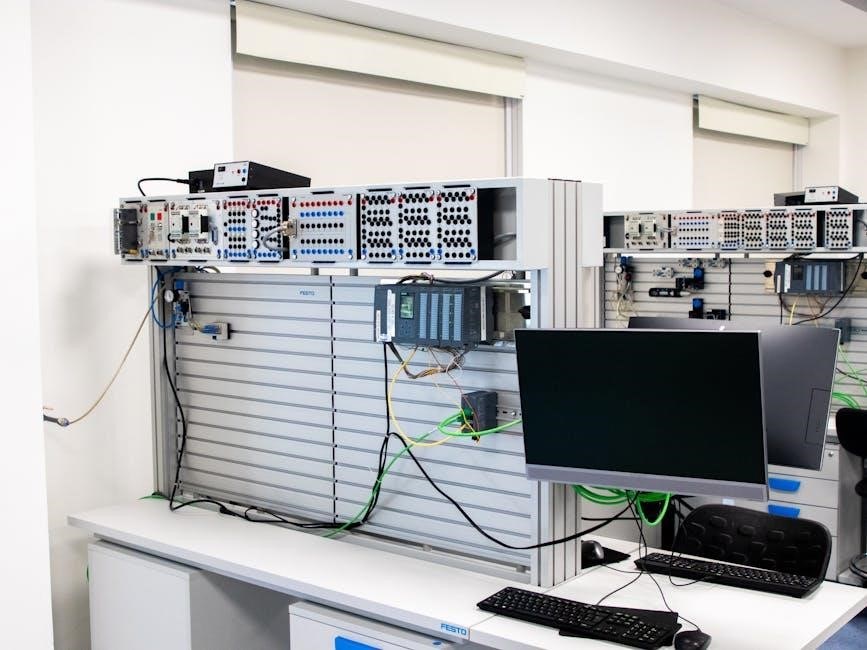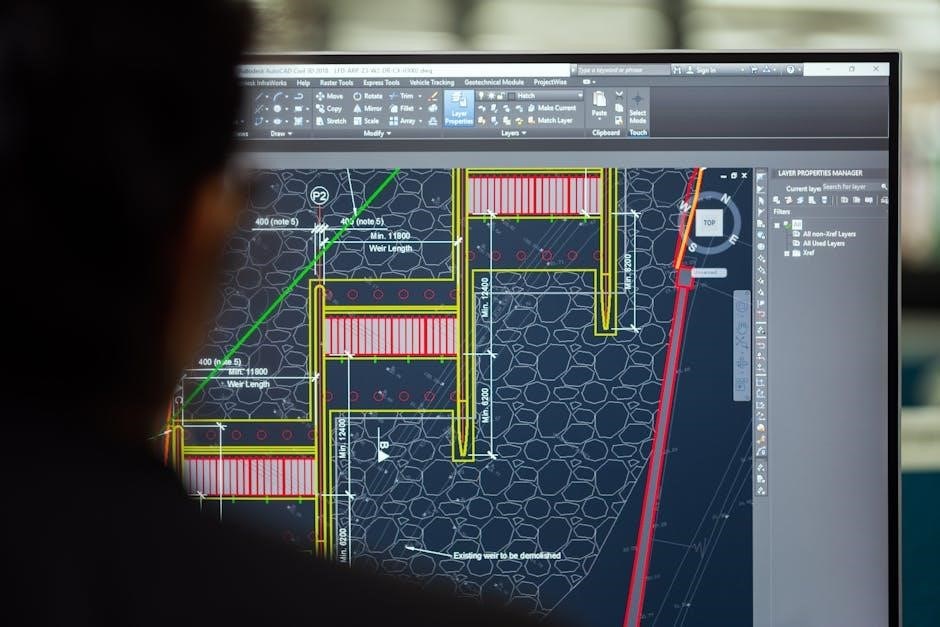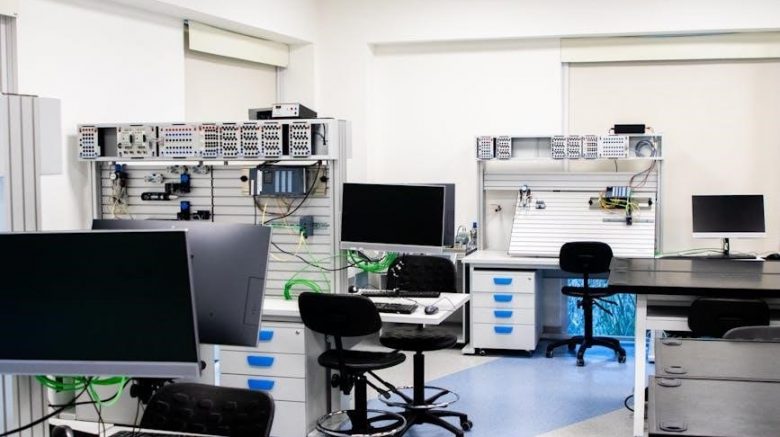Software Engineering: A Comprehensive Overview (filetype:pdf)

Dive into the world of software engineering with comprehensive PDF guides!
Explore fundamental concepts, development processes, and project management․
Delve into CASE tools, component models, and software reuse․
Access free books covering design, testing, and maintenance practices․

Software engineering, a critical technology for the future, involves building, maintaining, and evolving software systems․ More than just coding, it’s a systematic approach to software development․ It encompasses methods and techniques for creating large, reliable systems, demanding skilled professionals․ Software engineering addresses human aspects in development, ensuring efficiency and reliability․

Generative AI is reshaping software engineering roles, boosting developer productivity․ This tutorial provides a basic understanding of software products, design, development, and project management․ The field is rapidly evolving, demanding continuous learning․ Explore the fundamentals of software engineering and its impact on our technologically driven world․ Learn about its principles, methods and technologies․
Understand the difference between software and a program․ Discover how software engineering aims to develop reliable, efficient software economically․ Explore introductory materials and free PDF books covering various aspects of software engineering․ Software engineering is a key technology, vital for mankind’s future․ This introduction sets the stage for further exploration into this dynamic field․
Fundamentals of Software Engineering
The fundamentals of software engineering revolve around systematic and disciplined methods for developing reliable and efficient software․ Good software possesses attributes like reliability and efficiency, achieved through careful planning and execution․ Core principles involve understanding software requirements, design methodologies, and testing strategies․ Software engineers must grasp computer fundamentals and the software development process․
Essential concepts include software design, development, and maintenance․ Understanding different software process models is crucial for effective project management․ The field emphasizes quality assurance and adherence to established engineering practices․ Mastering these fundamentals allows for creating robust and scalable software solutions․ This involves knowing how to handle the complexities and challenges inherent in large-scale software projects․
Explore the vast world of software engineering with introductory resources and free PDF books․ Learn about design, development, testing, maintenance, project management, and quality assurance․ A solid grasp of these fundamentals is essential for any aspiring software engineer․ This foundation paves the way for advanced topics and specialized areas within the field․
Software Development Process Models

Software development process models are crucial frameworks that guide the creation and maintenance of software systems․ These models provide a structured approach, defining the stages and activities involved in the software lifecycle․ Understanding various models is essential for effective software engineering․ Common models include the Waterfall model, Agile methodologies, and the Spiral model, each with its strengths and weaknesses․
The Waterfall model is a linear, sequential approach, while Agile focuses on iterative development and customer collaboration․ The Spiral model emphasizes risk management and incremental development․ Choosing the right model depends on project requirements, team capabilities, and organizational constraints․ Each model impacts project planning, resource allocation, and overall project success․

Exploring these models through software engineering resources and PDF documents provides valuable insights․ Grasping the nuances of each model enables informed decision-making throughout the software development process․ Effective application of these models leads to improved software quality, reduced development costs, and enhanced customer satisfaction․ Process models are constantly evolving to adapt to new technologies and changing industry needs․
Software Requirements and SRS Document
Software requirements are the foundation of any successful software project․ They define what the software should do and how it should perform․ These requirements are meticulously documented in a Software Requirements Specification (SRS) document, serving as a blueprint for developers․ The SRS document outlines functional and non-functional requirements, ensuring a shared understanding between stakeholders․
Functional requirements describe specific actions the software must perform, while non-functional requirements address aspects like performance, security, and usability․ A well-defined SRS document reduces ambiguity and minimizes the risk of errors during development․ It serves as a reference point for testing and validation, ensuring the software meets the intended needs․
Analyzing and documenting software requirements is a critical step in the software development lifecycle․ Resources like software engineering PDFs offer valuable guidance on creating effective SRS documents․ Techniques like use case diagrams and user stories help capture requirements accurately․ Proper requirements management leads to better software quality, reduced development costs, and increased customer satisfaction․ Investing time in defining clear requirements is essential for project success․
Software Design and Development

Software design is the crucial stage where requirements transform into a tangible blueprint․ It involves creating a high-level architecture and detailed designs for individual components․ Effective software design ensures maintainability, scalability, and reliability․ Developers utilize design patterns and architectural styles to create robust and efficient systems․ UML diagrams are often employed to visualize the design and facilitate communication among team members․
Software development involves translating the design into executable code․ This phase requires strong programming skills and adherence to coding standards․ Various programming languages and development tools are used based on project requirements․ Agile methodologies promote iterative development and continuous integration, allowing for flexibility and faster delivery․ Testing is integrated throughout the development process to identify and fix defects early on․
Software design and development are intertwined processes, requiring close collaboration between designers and developers․ Software engineering PDFs provide insights into best practices for both design and development․ Topics include object-oriented design, software architecture, and coding principles․ Continuous learning and adaptation to new technologies are essential for software professionals․ The goal is to create high-quality software that meets user needs and business objectives․
Software Project Planning, Monitoring, and Control
Software project planning is the cornerstone of successful software development․ It involves defining project scope, setting realistic timelines, and allocating resources effectively․ Detailed project plans outline tasks, dependencies, and milestones․ Risk management is integral to planning, identifying potential issues and developing mitigation strategies․ Effective planning ensures that projects stay on track and within budget․

Monitoring involves tracking project progress against the plan․ Key performance indicators (KPIs) are used to measure performance and identify deviations․ Regular status meetings and progress reports keep stakeholders informed․ Monitoring helps in detecting potential problems early, allowing for timely corrective actions․ Tools like Gantt charts and project management software aid in visualizing and tracking progress․
Control involves implementing corrective actions to address deviations from the plan․ This may include reallocating resources, adjusting timelines, or modifying project scope․ Change management processes ensure that changes are properly evaluated and approved․ Effective control mechanisms minimize the impact of disruptions and maintain project momentum․ Software engineering PDFs offer detailed guidance on project planning, monitoring, and control techniques․ The goal is to deliver high-quality software on time and within budget․
Software Reliability and Fault-Tolerance
Software reliability is the probability of failure-free software operation for a specified period in a defined environment․ High reliability is crucial for critical applications like aerospace and medical systems․ Techniques to improve reliability include rigorous testing, formal verification, and code reviews․ Software reliability models help predict and assess reliability based on historical data and testing results․
Fault-tolerance is the ability of a system to continue operating correctly even in the presence of faults․ Fault-tolerant systems employ redundancy, such as duplicate hardware or software components, to mask failures․ Error detection and correction mechanisms are essential for fault tolerance․ Common fault-tolerance techniques include N-version programming, checkpointing, and recovery blocks․ Designing fault-tolerant systems requires careful consideration of potential failure modes and their impact on system operation․
Achieving both high reliability and fault-tolerance is a challenging but essential aspect of software engineering․ PDFs on software engineering often delve into these topics, providing methodologies and best practices․ Balancing cost, performance, and complexity is crucial when designing reliable and fault-tolerant systems․ The goal is to minimize the impact of software defects and ensure continuous, dependable operation, especially in safety-critical applications․ This is achieved through robust design, thorough testing, and proactive fault management․
Computer-Aided Software Engineering (CASE)
Computer-Aided Software Engineering (CASE) refers to the use of software tools to automate and support various activities in the software development lifecycle․ CASE tools aim to improve productivity, reduce development time, and enhance the quality of software products․ These tools can assist with requirements gathering, system design, code generation, testing, and project management․ CASE tools are often categorized as upper CASE, which supports early stages like planning and design, and lower CASE, which supports implementation and testing․
Integrated CASE (I-CASE) tools provide comprehensive support across the entire software development lifecycle․ The benefits of using CASE tools include increased consistency, improved communication among team members, and better documentation․ However, successful adoption of CASE tools requires careful planning, training, and integration with existing development processes․ PDFs on software engineering often cover CASE tools, providing insights into their features, benefits, and limitations․
The selection of appropriate CASE tools depends on the specific needs of the project and the organization’s development practices․ Modern CASE tools often incorporate features such as model-driven development, code generation from models, and automated testing capabilities․ By automating repetitive tasks and providing a structured approach to software development, CASE tools can significantly enhance the efficiency and effectiveness of software engineering teams․ They also facilitate better management and control over the software development process․
Component Model of Software Development
The component model of software development focuses on building software systems from reusable, independent components․ These components are self-contained units with well-defined interfaces, allowing them to be easily integrated into different applications․ This approach promotes modularity, reduces development time, and enhances software maintainability․ Component-based development emphasizes the use of pre-built components, either developed in-house or acquired from third-party vendors, to assemble complex systems․

Key principles of the component model include encapsulation, abstraction, and standardization․ Encapsulation ensures that the internal workings of a component are hidden from other parts of the system, while abstraction provides a simplified view of the component’s functionality․ Standardization ensures that components adhere to common interfaces and protocols, facilitating interoperability․ Frameworks like ․NET and Java EE provide extensive support for component-based development, offering tools and libraries for building and managing components․
Software engineering PDFs often discuss the benefits and challenges of component-based development, including issues related to component compatibility, versioning, and testing․ The component model encourages a “build once, use many times” approach, leading to significant cost savings and improved software quality․ It also enables faster development cycles, as developers can focus on assembling and integrating components rather than building everything from scratch․ This approach aligns well with modern software development practices, promoting agility and responsiveness to changing business needs․
Software Reuse
Software reuse is a critical aspect of modern software engineering, aiming to leverage existing software assets to reduce development time, cost, and effort․ It involves utilizing previously developed components, modules, or entire systems in new projects, rather than building everything from scratch․ This practice not only speeds up the development process but also improves software quality by reusing proven and tested code․

There are various levels of software reuse, ranging from code snippets and libraries to complete application frameworks․ Component-based development, as discussed in many software engineering PDFs, is a key enabler of reuse, allowing developers to integrate pre-built components seamlessly into their systems․ Design patterns, architectural styles, and domain-specific languages also contribute to software reuse by providing standardized solutions to common problems․
Benefits of software reuse include reduced development costs, faster time-to-market, improved software reliability, and increased developer productivity․ However, effective software reuse requires careful planning, documentation, and management of reusable assets․ Organizations need to establish clear guidelines for creating, storing, and retrieving reusable components․ Furthermore, it’s essential to address potential challenges such as compatibility issues, licensing restrictions, and the need for adaptation or customization․ Successfully implementing software reuse strategies can significantly enhance the efficiency and effectiveness of software development efforts․
Software Maintenance
Software maintenance is an essential phase in the software development lifecycle, encompassing all activities required to modify or update software after its initial delivery․ It ensures the software continues to meet user needs, adapt to changing environments, and remain reliable and efficient over time․ Maintenance activities can range from fixing defects and implementing enhancements to adapting the software to new platforms or technologies․
There are primarily four types of software maintenance: corrective, adaptive, perfective, and preventive․ Corrective maintenance addresses defects or bugs identified after deployment․ Adaptive maintenance involves modifying the software to accommodate changes in the operating environment, such as new hardware or software versions․ Perfective maintenance focuses on improving the software’s performance, usability, or maintainability․ Preventive maintenance aims to reduce the likelihood of future problems by improving the software’s structure or documentation․
Effective software maintenance requires a well-defined process, skilled personnel, and appropriate tools․ Maintenance teams must have a thorough understanding of the software’s design, code, and dependencies․ They also need to be proficient in debugging, testing, and version control․ Proper documentation is crucial for facilitating maintenance activities․ By investing in robust software maintenance practices, organizations can extend the lifespan of their software assets, reduce long-term costs, and ensure continued user satisfaction․
